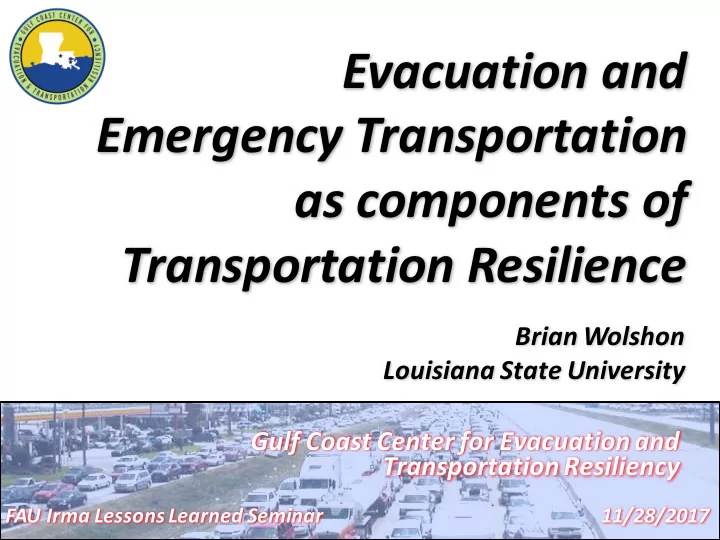

Evacuation and Emergency Transportation as components of Transportation Resilience Brian Wolshon Louisiana State University Gulf Coast Center for Evacuation and Transportation Resiliency FAU Irma Lessons Learned Seminar 11/28/2017
What is Disaster Resilience? • The term "resilience" means the ability to prepare for and adapt to changing conditions and withstand and recover rapidly from disruptions* • In the context of community resilience, the emphasis is not solely on mitigating risk, but implementing measures to ensure that the community recovers to normal, or near normal function, in a reasonable timeframe. *As defined in Presidential Policy Directive 21.
Resilience Concept Maintain acceptable levels of functionality during and after disruptive events Recover full functionality within a specified period of time Functionality Modifications before disruptive events that improve system performance Lost Aging Functionality System Repairs after disruptive event to Residual restore system Functionality Event functionality Time Time to Full Recovery Adapted from Bruneau, 2003 and McDaniels, 2008
Attributes of Resilience • Functionality – Resilience should be based on the ability of social systems to resume function within a prescribed period of time following an expected event. Buildings and infrastructure must be functional to support these social systems. • Interdependence – Resilience must consider the interdependence of buildings and infrastructure (functionality) and the relationship of individuals and organizations with the built environment.
Performance Levels for After- Event Evaluations Category Infrastructure System Performance Standard I Resume 100% service within days II Resume 90% service within weeks and 100% within months III Resume 90% service within months and 100% within years
Basic Principles of Emergency and Event Traffic Management • Stress transportation networks safety, capacity, and demand • Require reaching beyond “typical” transportation relationships continuous and inclusive cooperation, collaboration, and communication • Traffic management useful for incidents, events, emergencies, both planned and unplanned Gulf Coast Center for Evacuation and Transportation Resiliency
Basic Principles of Emergency and Event Traffic Management • Modeling and simulation depict & forecast conditions and test strategies • Advanced planning and coordination improves outcomes • Drill and test plans to train personnel in response and recovery and identify potential shortcomings before they occur Gulf Coast Center for Evacuation and Transportation Resiliency
Basic Planning Principles: Planned Events • Predictable in time and place) • Often predictable in terms of volumes and modes of travel • Traffic management strategies may include operational strategies, network modification strategies, and demand management strategies Gulf Coast Center for Evacuation and Transportation Resiliency
Basic Planning Principles: Unplanned Events • Can include traffic incidents & emergency events • Vary in scale, duration, & complexity • Can be managed using National Incident Management System (NIMS) and Incident Command System (ICS) procedures • Larger incidents require the Unified Command structure, (FHWA’s “Simplified Guide to Incident Command Structure for Transportation Professionals”) Gulf Coast Center for Evacuation and Transportation Resiliency
Common Operational Strategies for Event Traffic Management • Eliminate or restrict parking on routes into or away from the event • Enabling immediate towing of vehicles in restricted lanes • Eliminate or restrict left turns at key intersections • Extending signal timing in predominant directions (each comes with pros and cons) Gulf Coast Center for Evacuation and Transportation Resiliency
Common Operational Strategies for Event Traffic Management • Restrict traffic to buses-only near venue • Use law enforcement officers to protect pedestrian movements or facilitate vehicle movements at intersections • Set up detour routes for routine traffic • Reverse traffic flow on specific streets to facilitate movement (each comes with pros and cons) Gulf Coast Center for Evacuation and Transportation Resiliency
http://www.trb.org/
Evacuation
Evacuation Basics • TEMPORAL AND SPATIAL • Hazard Characteristics – Scale (how “big?” -> How far to evacuate), Amount of advanced notice, Shelter-in-place options • Evacuee Characteristics – Who are they? Where are they? How many? How mobile? Behavior (if/when will they leave?), What are their needs? • Transportation Resources – Modes, Highway Transit, Traffic Control, Traffic Management • Communications • To/from, Across and between all levels, jurisdictions, agencies, and evacuees, Need for situational awareness Gulf Coast Center for Evacuation and Transportation Resiliency
Hurricane Rita Evacuation - Interstate 45 (north of Houston) Photo Source: Lt. John Denholm Harris Co. (TX) Sheriff's Office
Photo Source: Yi-Chang Chiu, University of Arizona
Regional-Level Modeling and Visualization
Map Source: LaDOTD http://www.dotd.state.la.us/maps
78325 75725 73125 70525 67925 Westbound I-10 Traffic Speed 65325 62725 60125 57525 54925 52325 49725 47125 44525 41925 39325 36725 34125 31525 28925 26325 23725 21125 18525 15925 13325 10725 8125 5525 2925 325 0 6 12 18 24 30 36 42
(Map source: 2001 Florida Keys Hurricane Evacuation Study)
Scenario Testing and Evaluation Analysis of “variable” hazards and responses • Temporal – • More/less time to evacuate • implementation of phasing strategies • Spatial – • Storm size and direction of approach • network management
Megaregion Modeling • Evacuation Phasing • Network Management Baton Rouge Lake Charles N Houston New Lafayette Orleans Beaumont Port Arthur
Recommend
More recommend